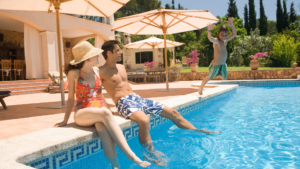 Swimming pools don’t require a lot of work but they do require a lot of energy, and the costs can add up quickly if you’re not careful. To get the most from their pool, homeowners need to think long-term. Creating an energy-efficient pool requires a bit of investment but pays for itself over time. It’s simple, straightforward, and a great improvement to your home.
Swimming pools don’t require a lot of work but they do require a lot of energy, and the costs can add up quickly if you’re not careful. To get the most from their pool, homeowners need to think long-term. Creating an energy-efficient pool requires a bit of investment but pays for itself over time. It’s simple, straightforward, and a great improvement to your home.
Invest in an Energy Star Pool Pump
Nothing in your pool consumes more energy than the water pump. Traditional pumps run at the highest possible speed whenever they’re switched on. This may sound good but circulating water at this rate burns a lot of electricity, often for tasks that don’t require it. Running your filter only requires half as much energy as running your cleaner, for example.
But while a traditional pump won’t let you control water flow, an Energy Star pump will. They come with variable speeds that adjust output based on function and time of day. A high-velocity pump is too noisy to run at night, but turning down the speed reduces the sound, so you can take advantage of off-peak prices while you sleep.
Keep in mind that Energy Star isn’t a brand. It’s a classification. Appliances with the Energy Star logo have the highest efficiency ratings on the market. You might pay more upfront, but the savings more than make up for it. Running your pump at half-speed cuts energy consumption by seven-eighths!
Switch to a Heat Pump
There are two ways to heat your pool: gas burners and heat pumps. Gas burners work by heating water in a combustion chamber powered by propane or natural gas. Heat pumps work by transferring energy from the environment to your pool, like a reverse air conditioner.
Warm air is pulled in over evaporator coils filled with compressed refrigerant. They absorb the heat, which is used to raise the temperature of your pool. It’s an incredibly efficient process. Heat pumps use 80 percent less power than a gas burner. Like Energy Star pumps, they have high upfront costs, but enormous long-term savings.
Maintain Your Pool & Filtration System
It’s hard to circulate water through a dirty pool. Too much gunk restricts water flow, which forces the pump to work harder. To keep everything working smoothly:
- Clear Debris Off Grates. Open drains let water flow with minimal effort.
- Upgrade to an Automatic Cleaner. Automatic cleaners not only save time but they can also be set to run at night when energy prices are low. In addition, automating the process ensures you never miss a cleaning, so gunk doesn’t get a chance to build up.
- Clean the Cleaning System. Cleaning systems need maintenance too, otherwise, performance suffers. Check with the manufacturer so you know how often your system needs to be cleared out.
- Install Larger Filters. Because water flows faster through large openings than small ones, switching to large filters makes it easier to pump water through your pool.
Pick a Darker Finish
Most pools have a white finish, which reflects heat into the environment. A dark finish, on the other hand, absorbs heat and keeps your pool warm.
Minimize Evaporation
Pools lose most (70%) of their heat through evaporation. It takes 8.33 BTUs (British Thermal Units) in order to heat a gallon of water one degree. But when a gallon of water evaporates, it takes a whopping 8,500 BTUs out of your pool.
There are ways to fight it, however. The first is pool covers: a simple plastic barrier that prevents heat and vapor from escaping the pool when it’s not in use. What’s more, there are also specialized covers made from polyethylene, polypropylene, and vinyl that not only last longer but help heat your pool with solar energy.
The second is windbreakers. Winds clear vapor from the pool’s surface, which speeds up evaporation. Blocking wind flow with a hedge, terrace, or wall disrupts the process, keeping heat loss to a minimum. Just make sure the windbreaker doesn’t cast too large a shadow or it will lower your water temperature.
Install LEDs
Retrofitting your pool with LEDs (Light-Emitting Diodes) is one of the fastest and cheapest ways to create an energy-efficient pool. A standard incandescent bulb can only run for 1,200 hours. An LED, on the other hand, can run for 50,000-100,000 hours and consumes 85 percent less electricity.
Turn Down Your Thermostat
The recommended temperature for most pools is 78-82°F. Adjusting your thermostat as much as one degree can raise or lower energy consumption by 10-30 percent. Setting your thermostat low in the summer lets you maintain a comfortable temperature for a much lower cost, so you stay cool and save money.